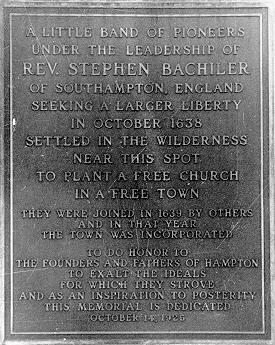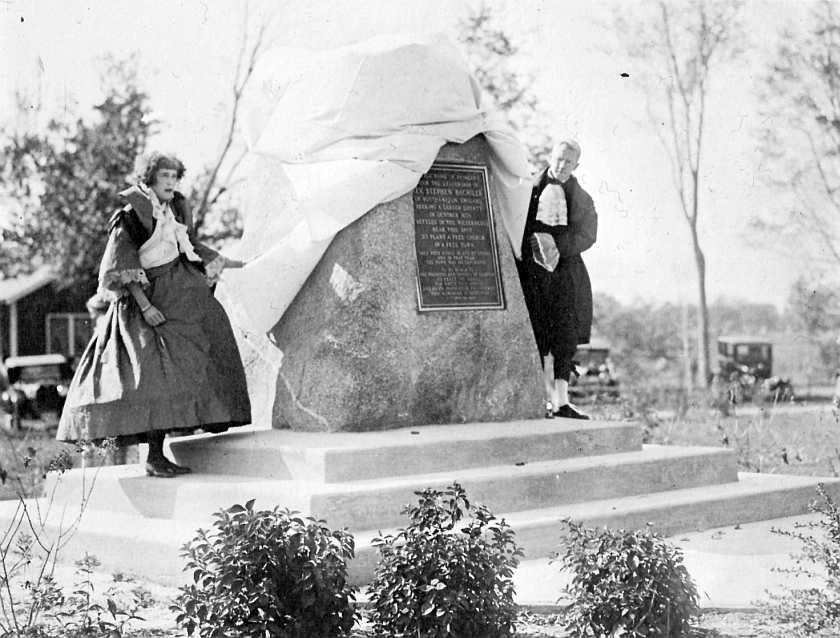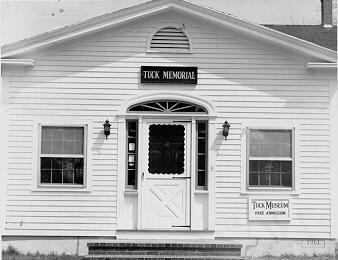By John M. Holman, Contributing Writer
UNDER THE LEADERSHIP OF
REV. STEPHEN BACHILER
OF SOUTHAMPTON, ENGLAND,
SEEKING A LARGER LIBERTY,
IN OCTOBER 1638,
SETTLED IN THE WILDERNESS
NEAR THIS SPOT
TO PLANT A FREE CHURCH
IN A FREE TOWN.
THEY WERE JOINED IN 1639 BY OTHERS
AND IN THAT YEAR
THE TOWN WAS INCORPORATED.
TO DO HONOR TO
THE FOUNDERS AND FATHERS OF HAMPTON,
TO EXALT THE IDEALS
FOR WHICH THEY STROVE,
AND AS AN INSPIRATION TO POSTERITY,
THIS MEMORIAL IS DEDICATED
OCTOBER 14, 1925.
Tuck Athletic Field … Founder’s Park … Meeting House Green Memorial and Historical Association (now called The Hampton Historical Society) … Tuck Memorial Museum. All can be attributed to one man’s idea and fulfillment.
His name was REV. IRA S. JONES, and back in 1925, he saw the culmination of his dream with the dedication of a memorial park and the founding of an historical association to honor the founders of the first settlement at “Winnacunnet” in 1638, when a year later, it became the town of HAMPTON.
Rev. Jones, although not a native of Hampton, was deeply interested in the community’s rich historical past. Having read Dow’s HISTORY OF HAMPTON over and over, and having researched the various historical landmarks in Hampton, he felt that a memorial should be built to honor the early settler of the town.
Rev. Jones first interested philanthropist Edward Tuck of Paris, France, in the project. Tuck made funds available to purchase the Fogg property on Park Avenue and it was named “TUCK MEMORIAL” in his honor. The building was renovated from top to bottom and a portion of it was set aside to house various antiques of Hampton that people had donated. This section, originally called “Tuck Hall”, later became known as he “TUCK MEMORIAL MUSEUM”. An addition was built in 1961 to accommodate increasing numbers of artifacts and relics from the past.
Edward Tuck also contributed funds for landscaping adjacent land to be known as Meeting House Green Memorial Park or Founder’s Park for short.
This triangular piece of land across the street from the Tuck Museum was laid out as a memorial to the founders of Hampton and in the center was placed a twelve-ton boulder with a plaque bearing the inscription:
On the perimeter of the park were placed memorial stones with the family names of the early settlers who came to Hampton in 1638, and along the sides and at the three corners were placed larger boulders marked with the names of the various towns making up the original township of Hampton. These included Hampton, Hampton Falls, North Hampton, Kensington, East Kingston, Kingston, Danville, Sandown and Seabrook. Although Rye was also part of the original Hampton township, no stones from Rye was installed at that time. Subsequently, A Rye stone has been placed on the Park.
Fifty-five trees were also planted on the triangle in memorial of the older families in Hampton. Founders Park was dedicated on October 14, 1925 and this date became known as “FOUNDERS DAY”. View photos of the Founder’s Day parade here.
Much of the cleaning up and grading of the land for the park was done by Rev. Jones himself, even though he was in his 88th year. He also assumed the executive duties of the project, corresponding with Edward Tuck in Paris and seeing to it that the funds were spent in the most practical and efficient manner.
When the dedication day finally arrived on October 14, 1925, great festivities were planned by the town. The memorial boulder was unveiled by Horace Batchelder and his sister Elsie (photo at right), direct descendants of the founder of the town, STEPHEN BACHILER.
A log cabin replica, since gone through rot and decay, was built as a model of the first meeting house near the spot of the original one. The early meetings of the historical association were held in the log cabin and its first president was Rev. Jones.
The Tuck Memorial Museum, which today serves as a repository for the many historical artifacts of Hampton, is open during the summer to the general public and is staffed by volunteers and the admission is FREE. Check the local newspaper for the exact hours of operation in the summer.
After the 1925 dedication of the Founders Park, Rev. Jones turned his attention to the idea of an athletic field for use as a playground for the children of the town. He again contacted Edward Tuck about his plan, but before the Tuck Athletic Field was to become a reality, Rev. Jones passed away in 1927. Ironically, a check from Mr. Tuck in the amount of $10,000 arrived on the very day of Jones’ death!
Mrs. Vina Jones took up where her husband left off, and carried on the project of Tuck Field to its completion. It was dedicated on June 4, 1930 and is still in use by the youth today and is still known as TUCK FIELD.
How many young people have used Tuck Field these many years, one could never count. But if Rev. Ira S. Jones could see the happy faces of these youngsters of Hampton playing sports and other activities, he would be justly proud.


